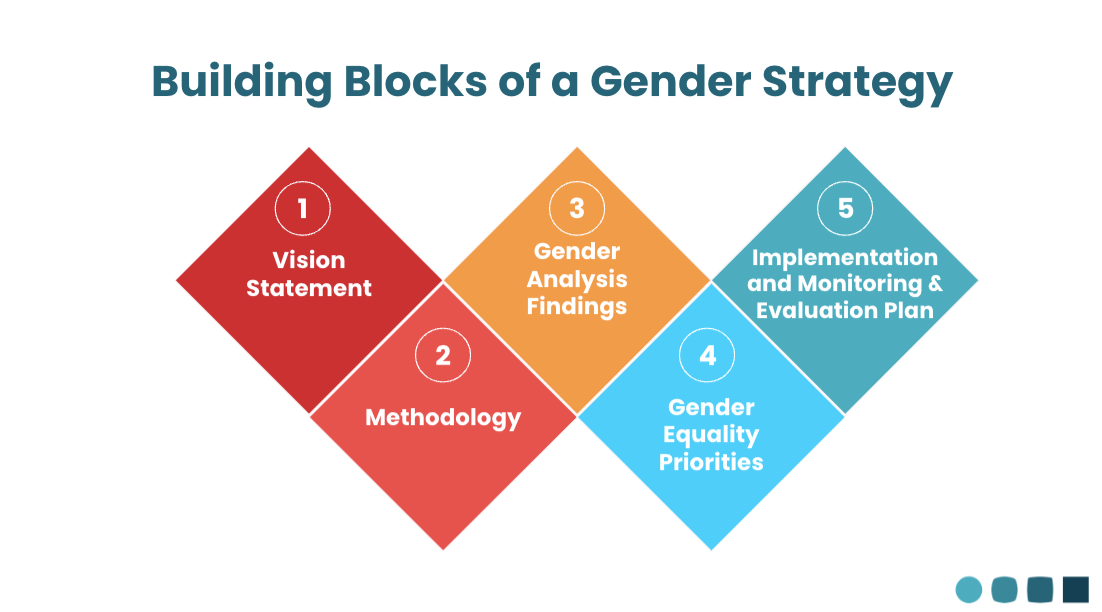Top tips for designing a gender equality strategy
Kore Global provides long-term gender equality advisory support to Grand Challenges Canada (GCC). As part of this ongoing support, and in line with GCC’s commitments to gender equality, Kore Global facilitated a participatory training for staff on the topic of developing gender equality strategies. The focus was on how best to support GCC investees, innovators in the health and humanitarian sectors, to adopt a gender and inclusion lens across all aspects of their work. GCC requires innovators to develop a gender strategy when their innovation is approved for further funding and scaled up, in order to identify and track key gender commitments at both programmatic and organizational levels, with the overall aim of contributing to the achievement of gender equality. Kore Global acts as an advisor to innovators on their gender strategies, providing tailor-made support and advice that is right-sized to the innovation.
A gender strategy outlines an organization’s overall approach to gender equality and inclusion and provides a framework to define and implement measurable and trackable goals and actions. It also formally articulates an organization’s commitment to achieving gender equality outcomes and builds in accountabilities by assigning responsibilities to people within the organization. The process of designing a gender strategy can be catalytic for an organization, giving individuals the opportunity to think about and discuss gender and inclusion and beginning a process of integrating gender equality into the organizational culture.
Through this support to over 30 GCC-funded innovators, Kore Global has learned a lot about what works best for gender strategy development. Broadly, we recommend that a gender strategy is based on five key building blocks which are: Vision Statement; Methodology; Gender Analysis Findings; Gender Equality Priorities; and Implementation and Monitoring & Evaluation Plan.
Here are some top tips on designing gender strategies based on Kore Global’s experience with GCC-funded innovators:
The gender strategy should be right-sized to the organization. Different organizations are at different stages of their gender equality journeys and the strategy should provide the organization with clear, realistic goals. It is not always necessary to add new initiatives to what an organization is already doing; bringing a gender lens to existing activities can be a starting point.
The methodology for the gender strategy should be based on organizational capacity. The methodology can range from a simple, lighter-touch approach where for instance a gender focal point takes the responsibility for designing the strategy and presenting it to the organization. A more participatory and higher-touch approach could involve staff surveys, community consultations and focus groups, as well as desk research on key gender issues. This approach is more transformative but can also be time-consuming and requires resources that not all organizations have.
A gender analysis is at the heart of a gender strategy, as it identifies the specific barriers, challenges and opportunities faced by individuals with different gender identities in a particular context. The analysis should be relevant to the intervention the organization is implementing but also consider the wider socioeconomic and political context. An intersectional analysis will consider multiple, overlapping and intersecting identities for a more nuanced understanding of exclusion and marginalization.
The strategy must have an implementation and monitoring and evaluation plan with clear, measurable and time-bound actions that give the organization something to aim for within a particular program or funding cycle. This helps avoid the risk of gender priorities being postponed or forgotten.
Accountabilities must be in place including how and when the strategy will be reviewed and reported on and who is accountable for its implementation in senior management. This ensures that gender and inclusion work is prioritized within the organization.
The organization must have the adequate capacity and resources to achieve its gender equality priorities. This is why it’s so important to make sure the strategy is realistic and right-sized. The organization can then identify any resource gaps that can be filled either internally or externally.
Written by Dharini Bhuvanendra, Consultant, Kore Global.


